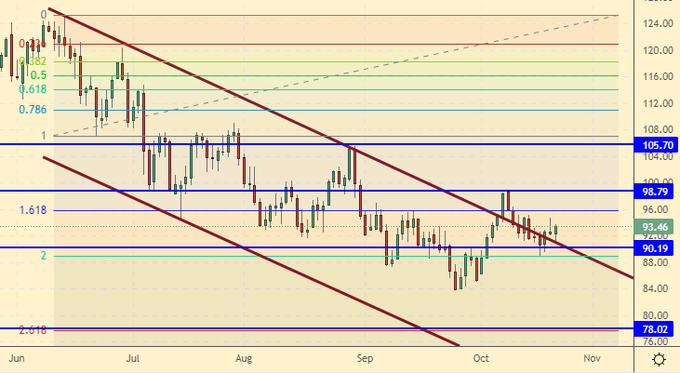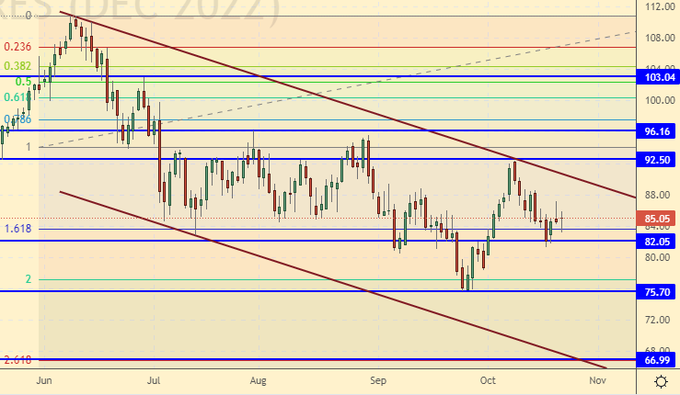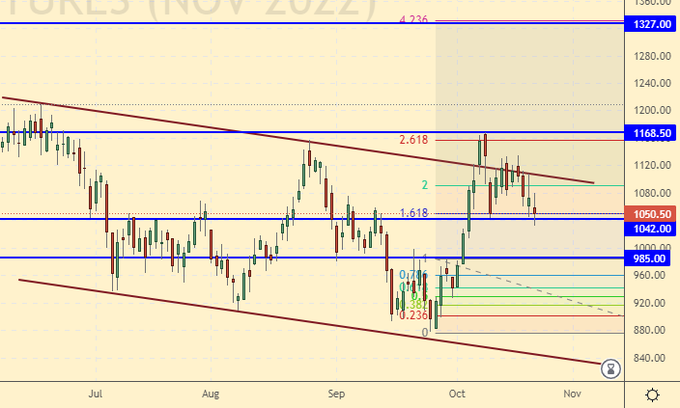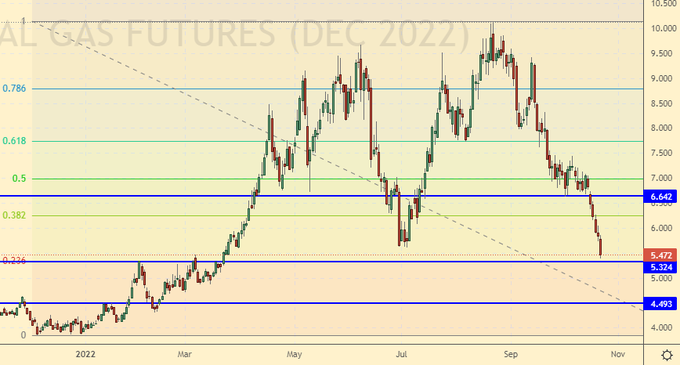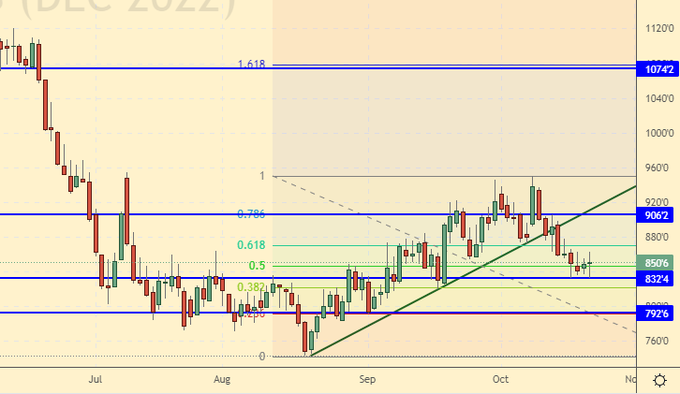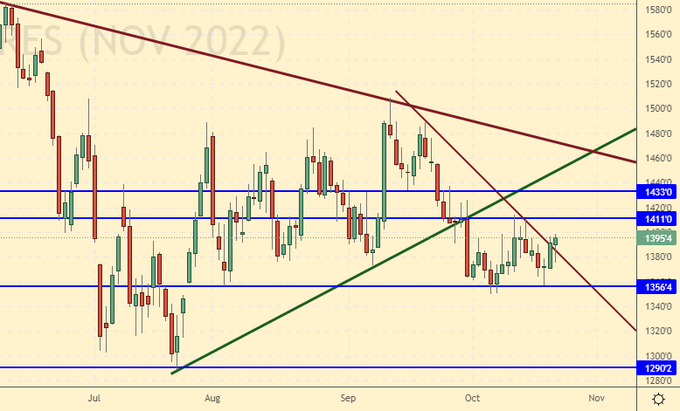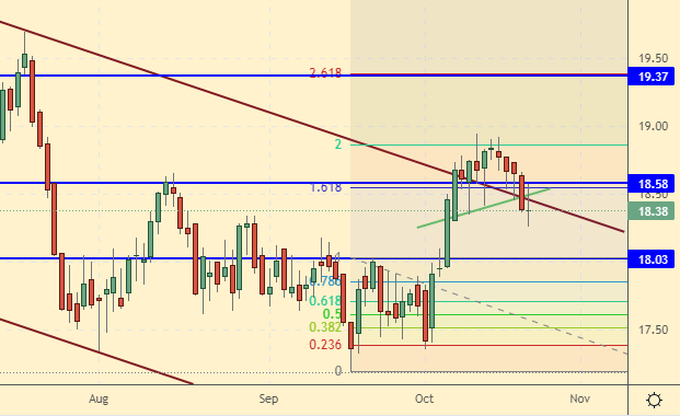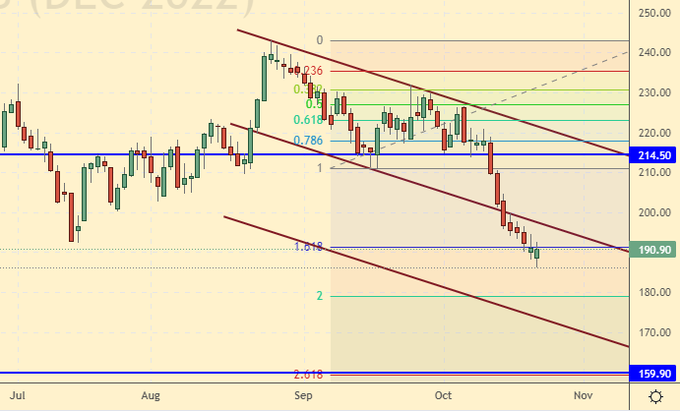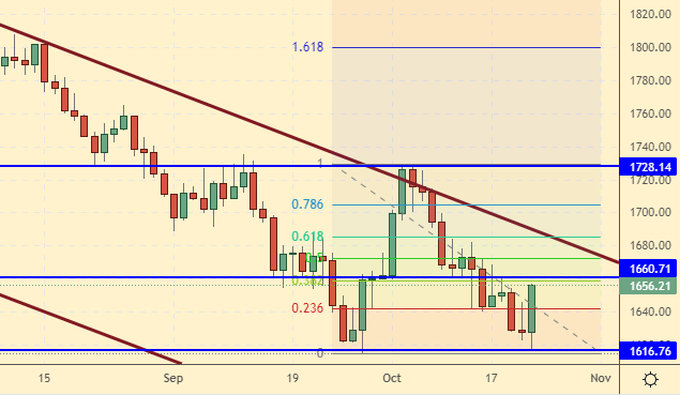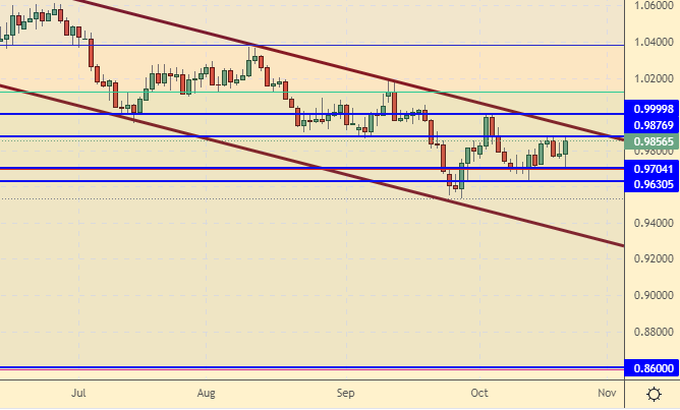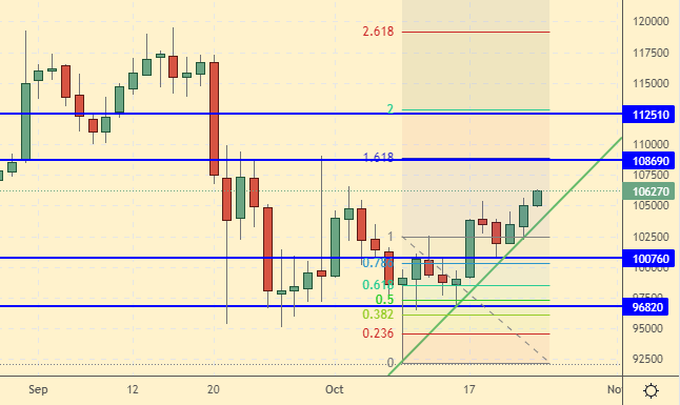Price forecast from 24 to 28 of October 2022
-
Energy market:
Europe was able to accumulate enough gas to survive the winter. There is no more fear of the cold, though you will have to sit in the office or at home at +17, which is uncomfortable, but you can go to rallies and demand an increase in temperature to +20.
And all you needed was nothing: spend some money on one big balloon, fill it with natural gas and send all your politicians on a trip.
All hot cups of tea. Hello!
This issue has been prepared with the direct participation of analysts from eOil.ru and IDK.ru trading platforms.
London and Washington began to work closely with India to join their idea of buying oil at a price set by the Americans. If Delhi falls under the onslaught of insolent people, then this will lead to the fact that Moscow will refuse direct supplies to this country. The formula was announced at all levels: whoever tries to dictate their pricing policy to us will be without oil.
December 5, the date of the West’s embargo on Russian oil, is getting closer. If nothing terrible happens and Asia continues to buy Russian energy resources, then oil production in Russia due to the closure of the European market will decrease by 0.5 million barrels per day, while about 1 million barrels per day will be redirected to Asia, in including with the help of tankers, which, as it turns out, are enough.
Oil prices might have fallen in the current situation to around $80.00 per barrel, for example, against the backdrop of economic problems in China or because of a strong dollar, but since the embargo is coming and everyone is scared, we will most likely be higher level 90.00.
Reading our forecasts, you could make money on the RTS index by taking a downward move from 118,000 to 106,000 points.
Grain market:
Domestic grain prices remain at low levels. The further north, the lower the price. If close to the ports the price of wheat with a protein content of 12.5% can be at the level of 14,000 rubles per ton, then as the distance from export terminals increases, it drops to 12,000 rubles.
Assuming that Russia will harvest 100 million tons of wheat this year, we can assume that prices will remain at current levels for several more months. At the same time, a slight increase in prices should begin in January. Further, everything will depend on how successful the export will be. In October, shipments abroad are estimated at 4 million tons, and this is clearly not the pace that will allow more than 50 million tons of surplus to be taken out of the country before the middle of next year.
While the prospects of the sowing company in Ukraine are not clear, it is premature to talk about a decrease in prices on the grain market. At the same time, if we assume that there is no tension in the Black Sea region, there will still be no return of prices to the levels of 2020 due to expensive fertilizers and fuel.
USD/RUB:
From the point of view of technical analysis, prerequisites appeared on the market for strengthening the positions of the American currency. However, since there is a large influx of dollars into the country, we will see a depreciation of the ruble only with the direct participation of the Central Bank of Russia.
At the moment, the exchange rate of the national currency is a more political issue than an economic one. For Russia, which is under sanctions, stability is more important than ever. Let it be 60 rubles for 1 US dollar. This is the ratio to which the people got used in four months.
Note that the Fed’s rate hike, which is likely to take place on November 2, is unlikely to have any effect on the ruble. They have their own market, and we have ours.
Brent. ICE
We’re looking at the volume of open interest of managers. You should keep in your mind that these are data from three days ago (for Tuesday of the past week), they are also the most recent of those published by the ICE exchange.
At the moment, there are more open long positions of asset managers than short ones. Buyers control the market. Over the past week, the difference between long and short positions of managers has decreased by 20.6 thousand contracts. The change is significant. Buyers closed a large number of positions while sellers entered the market. The spread between longs and shorts has narrowed, but the bulls remain in control.
Growth scenario: consider the October futures, the expiration date is October 31. The current levels remain attractive for purchases. The prerequisites for growth continue to form.
Fall scenario: the market failed to go below the 88.00 level, which we identified as a key one last week. We do not sell.
Recommendations for the Brent oil market:
Purchase: now. Stop: 87.00. Target: 110.00. Who is in position from 92.00, keep the stop at 87.00. Target: $110.00 per barrel.
Sale: no.
Support — 90.19. Resistance is 98.79.
WTI. CME Group
US fundamental data: the number of active drilling rigs increased by 2 units and now stands at 612 units.
Commercial oil reserves in the US fell by -1.725 to 437.357 million barrels, while the forecast was +1.38 million barrels. Inventories of gasoline fell by -0.114 to 209.368 million barrels. Distillate inventories rose by 0.124 to 106.187 million barrels. Inventories at Cushing rose by 0.583 to 26.23 million barrels.
Oil production increased by 0.1 to 12 million barrels per day. Oil imports fell by -0.155 to 5.908 million bpd. Oil exports rose by 1.266 to 4.138 million barrels per day. Thus, net oil imports fell by -1.421 to 1.77 million barrels per day. Oil refining fell by -0.4 to 89.5 percent.
Gasoline demand rose by 0.402 to 8.678 million barrels per day. Gasoline production increased by 0.213 to 9.381 million barrels per day. Gasoline imports fell -0.224 to 0.475 million bpd. Gasoline exports fell -0.271 to 0.781 million bpd.
Demand for distillates fell by -0.298 to 4.072 million barrels. Distillate production increased by 0.16 to 5.023 million barrels. Distillate imports rose by 0.032 to 0.111 million barrels. Distillate exports fell -0.222 to 1.044 million barrels per day.
Demand for petroleum products rose by 1.49 to 20.761 million barrels. The production of petroleum products increased by 1.242 to 22.01 million barrels. Imports of petroleum products fell by -0.031 to 1.831 million barrels. Exports of petroleum products fell by -1.726 to 5.33 million barrels per day.
Demand for propane rose by 0.591 to 1.486 million barrels. Propane production increased by 0.066 to 2.56 million barrels. Propane imports rose by 0.005 to 0.08 million barrels. Propane exports fell by -0.432 to 1.086 million barrels per day.
We look at the volumes of open interest on WTI. You should keep in mind that these are data from three days ago (for Tuesday of the last week), they are also the most recent of those published by the CME Group exchange.
At the moment, there are more open long positions of asset managers than short ones. Buyers control the market. Last week the difference between long and short positions of managers decreased by 29.5 thousand contracts. The change is significant. Buyers left the market, while sellers entered it in approximately the same volume. The spread between long and short positions has narrowed, but the bulls remain in control.
Growth scenario: we consider the December futures, the expiration date is November 21. We will continue to recommend purchases despite Washington’s keen desire to reduce prices by any means.
Fall scenario: we refuse to sell. There are chances for a fall, but they are small given the coordinated position of the OPEC + countries.
Recommendations for WTI oil:
Purchase: now. Stop: 80.30. Target: 103.00. Those who are in positions from 85.00 and 82.10, move the stop to 80.30. Target: $103.00 per barrel.
Sale: no.
Support — 82.05. Resistance is 92.50.
Gas-Oil. ICE
Growth scenario: we are considering the November futures, the expiration date is November 10. We will recommend shopping again. The situation with fuel due to the conflict between the West and Russia will not be easy.
Fall scenario: sales looks like a risky business, but in this case it makes sense to put some money on the continuation of the fall.
Gasoil recommendations:
Purchase: now. Stop: 1030.0. Target: 1320.0. Those in positions between 1055.00 and 1090.00 move the stop to 1030.00. Target: 1325.00.
Sale: now. Stop: 1090.0. Target: 900.0?
Support — 985.00. Resistance is 1168.50.
Natural Gas. CME Group
Growth scenario: switched to December futures, expiry date 28 November. Good place for shopping. Long is recommended again.
Fall scenario: we continue to refuse shorts. Despite the fact that Europe, according to politicians, has solved its problems with gas, it may not be enough for it.
Recommendations for natural gas:
Purchase: now. Stop: 4.800. Target: 15.000!!!
Sale: no.
Support — 5.324. Resistance is 6.642.
Wheat No. 2 Soft Red. CME Group
Let’s look at the volumes of open interest of managers in wheat. You should keep in mind that these are data from three days ago (for Tuesday of the last week), they are also the most recent of those published by the CME Group exchange.
At the moment, there are more open short positions of asset managers than long ones. Sellers control the market. Over the past week, the difference between long and short positions of managers increased by 3.1 thousand contracts. The change is minor. There were slightly more sellers than buyers. The spread between short and long positions widened, sellers strengthened their advantage.
Growth scenario: consider the December futures, the expiration date is December 14th. The market has gone to the 830.0 area twice. It is possible that there will be a puncture to the level of 820.0, but perhaps not. Buy at current levels. We will also carry out purchases from 820.0.
Fall scenario: holding shorts. The market may surprise by dropping to 750.0.
Recommendations for the wheat market:
Purchase: now. Stop: 828.0. Target: 1070.0. Also when approaching 820.0. Stop: 808.0. Target: 1070.0.
Sale: no. Who is in position from 853.0, move the stop to 863.0. Target: 820.0 (750.0) cents per bushel.
Support — 832.4. Resistance — 906.2.
We’re looking at the volume of open interest of managers. You should keep in your mind that these are data from three days ago (for Tuesday of the past week), they are also the most recent of those published by the CME Group.
At the moment, there are more open long positions of asset managers than short ones. Buyers control the market. Last week the difference between long and short positions of managers decreased by 15.2 thousand contracts. The buyers left the market and the sellers entered it in approximately the same volume. The spread between long and short positions has narrowed, the advantage of the bulls has slightly decreased.
Growth scenario: consider the December futures, the expiration date is December 14th. As long as the bulls manage to defend the 670.0 level, they will be safe, but if it is broken down, there may be a quick stop loss closing, which will lead to a strong fall. We hold longs, we do not open new positions.
Fall scenario: a sharp downward blow suggests itself. You just need to find a couple of hundred million dollars and go short. A good position to disperse all the bulls.
Recommendations for the corn market:
Purchase: no. Who is in position from 680.0, keep the stop at 670.0. Target: 750.0 cents per bushel.
Sale: no. Who is in position from 688.0, move the stop to 701.0. Target: 550.0 cents per bushel.
Support — 674.0. Resistance — 700.0.
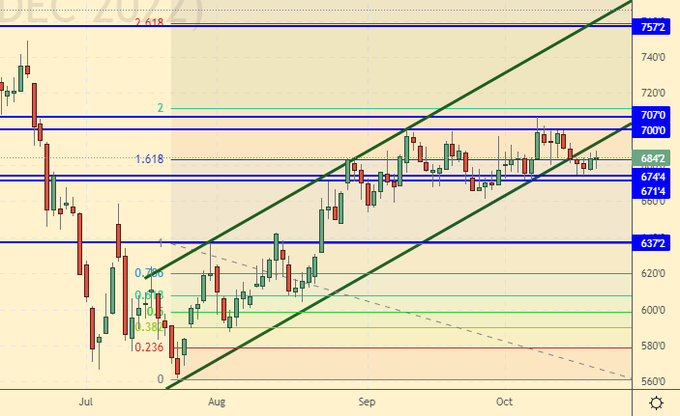
Soybeans No. 1. CME Group
Growth scenario: we are considering the November futures, the expiration date is November 14th. Soy has indicated support at 1350, but we will refrain from buying for now.
Fall scenario: we can rise to 1440.0. If this happens, we will sell. For open positions, we will move the stop order closer to the current prices.
Recommendations for the soybean market:
Purchase: no.
Sell: when approaching 1440.0 Stop: 1447.0. Target: 1000.0. Those in positions from 1420.0, 1400.0 and 1390.0 move the stop to 1412.0. Target: 1000.0 cents per bushel.
Support — 1356.4. Resistance is 1411.0.
Sugar 11 white, ICE
Growth scenario: we consider the March futures, the expiration date is February 28. Falling by 6 pm is not ruled out. If this happens, we will buy it.
Falling scenario: we started to draw a correction to the growth phase. It is unlikely to be long. We do not sell.
Recommendations for the sugar market:
Purchase: when rolled back to 18.00. Stop: 17.60. Target: 19.37. Who is in position from 18.30, move the stop to 18.20. Target: 19.37 cents a pound.
Sale: think when approaching 19.37.
Support — 18.03. Resistance — 18.58.
Сoffee С, ICE
Growth scenario: consider the December futures, the expiration date is December 19. The sellers thwarted all our plans. Out of the market.
Fall scenario: continue to hold shorts. On the rise to 210.0, it is worth increasing the shorts.
Recommendations for the coffee market:
Purchase: no.
Sale: on the rise to 210.0. Stop: 223.0. Target: 160.00. Who is in position from 220.0, move the stop to 193.00. Target: 150.00 cents per pound.
Support — 159.90. Resistance is 214.50.
Gold. CME Group
Growth scenario: Friday’s green candle raises questions. Who are they, and where did they come from? Rumor has it that physical gold is in short supply, as is silver. If we rise above 1700 we will think about buying.
Fall scenario: holding shorts. Friday’s candle is unpleasant, but for now we endure.
Recommendations for the gold market:
Purchase: think after rising above 1700.
Sale: no. If you are in position from 1700, move your stop to 1701. Target: $1480 per troy ounce.
Support — 1616. Resistance — 1660.
EUR/USD
Growth scenario: EUR in a range before the ECB meeting on the 27th. There will be no surprises. If the rate is raised, then only by 0.25%. It is unlikely that we will be able to get out of the falling channel upwards.
Fall scenario: despite the rebound, we will continue to recommend selling. We go short from current levels.
Recommendations for the EUR/USD pair:
Purchase: no.
Sale: now. Stop: 0.9880. Target: 0.8600.
Support — 0.9704. Resistance is 0.9999.
USD/RUB
Growth scenario: everything is calm. From a technical point of view, the chances for the continued growth of the dollar are not bad. If we make new purchases, then only when we approach the level of 60.00 rubles per dollar. We keep open longs.
Fall scenario: the market does not yet react to a large surplus in foreign trade. The ruble is not strengthening and this raises questions about its strength in the near future. We do not sell.
Recommendations for the dollar/ruble pair:
Purchase: When falling to 60.00 and 59.00. Stop: 57.40. Target: 74.00. Who is in position from 61.60, keep the stop at 57.40. Target: 74.00.
Sale: no.
Support — 59.61. Resistance — 64.87.
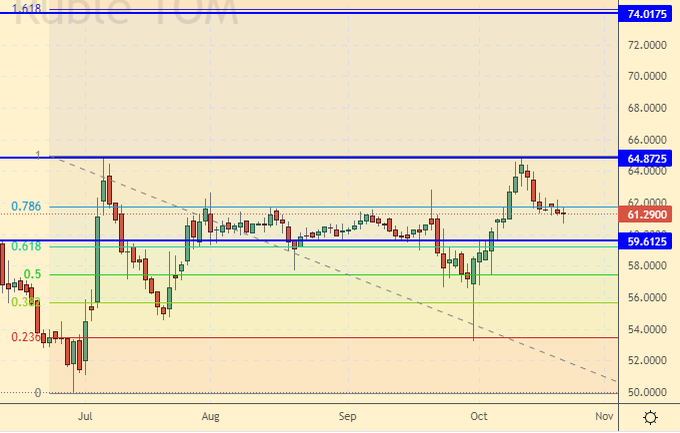
RTSI
Growth scenario: consider the December futures, the expiration date is December 15th. There is only one question: are we growing from scratch, or is there a reason for this growth. If we proceed from the fact that someone knows something in the market, then we will have to go long, no matter how strange this strengthening is.
It should be noted that the current purchases are bets on the soon end of the conflict in Ukraine. It is absolutely impossible to imagine the growth of the stock market if the confrontation continues.
Fall scenario: without a positive news background, we will look for opportunities to enter shorts when approaching the level of 112000. If there are hints of an agreement between Russia and Ukraine, do not open shorts.
Recommendations for the RTS index:
Purchase: now. Stop: 99000. Target: 120000.
Sale: when approaching 112000. Stop: 116000. Target: 80000 (50000) points.
Support — 100760. Resistance — 108690.
The recommendations in this article are NOT a direct guide for speculators and investors. All ideas and options for working on the markets presented in this material do NOT have 100% probability of execution in the future. The site does not take any responsibility for the results of deals.

